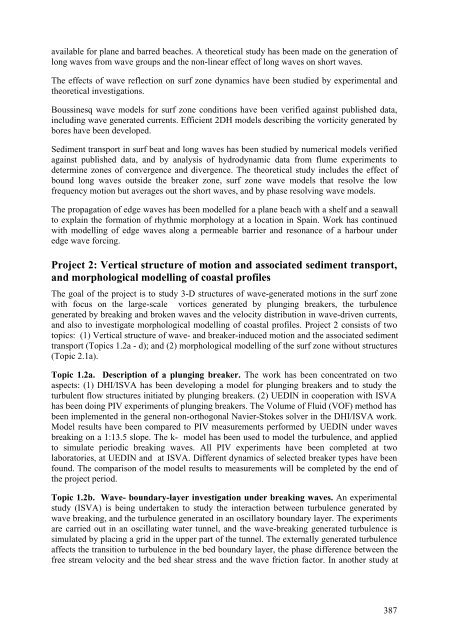EurOCEAN 2000 - Vlaams Instituut voor de Zee
EurOCEAN 2000 - Vlaams Instituut voor de Zee
EurOCEAN 2000 - Vlaams Instituut voor de Zee
You also want an ePaper? Increase the reach of your titles
YUMPU automatically turns print PDFs into web optimized ePapers that Google loves.
available for plane and barred beaches. A theoretical study has been ma<strong>de</strong> on the generation of<br />
long waves from wave groups and the non-linear effect of long waves on short waves.<br />
The effects of wave reflection on surf zone dynamics have been studied by experimental and<br />
theoretical investigations.<br />
Boussinesq wave mo<strong>de</strong>ls for surf zone conditions have been verified against published data,<br />
including wave generated currents. Efficient 2DH mo<strong>de</strong>ls <strong>de</strong>scribing the vorticity generated by<br />
bores have been <strong>de</strong>veloped.<br />
Sediment transport in surf beat and long waves has been studied by numerical mo<strong>de</strong>ls verified<br />
against published data, and by analysis of hydrodynamic data from flume experiments to<br />
<strong>de</strong>termine zones of convergence and divergence. The theoretical study inclu<strong>de</strong>s the effect of<br />
bound long waves outsi<strong>de</strong> the breaker zone, surf zone wave mo<strong>de</strong>ls that resolve the low<br />
frequency motion but averages out the short waves, and by phase resolving wave mo<strong>de</strong>ls.<br />
The propagation of edge waves has been mo<strong>de</strong>lled for a plane beach with a shelf and a seawall<br />
to explain the formation of rhythmic morphology at a location in Spain. Work has continued<br />
with mo<strong>de</strong>lling of edge waves along a permeable barrier and resonance of a harbour un<strong>de</strong>r<br />
edge wave forcing.<br />
Project 2: Vertical structure of motion and associated sediment transport,<br />
and morphological mo<strong>de</strong>lling of coastal profiles<br />
The goal of the project is to study 3-D structures of wave-generated motions in the surf zone<br />
with focus on the large-scale vortices generated by plunging breakers, the turbulence<br />
generated by breaking and broken waves and the velocity distribution in wave-driven currents,<br />
and also to investigate morphological mo<strong>de</strong>lling of coastal profiles. Project 2 consists of two<br />
topics: (1) Vertical structure of wave- and breaker-induced motion and the associated sediment<br />
transport (Topics 1.2a - d); and (2) morphological mo<strong>de</strong>lling of the surf zone without structures<br />
(Topic 2.1a).<br />
Topic 1.2a. Description of a plunging breaker. The work has been concentrated on two<br />
aspects: (1) DHI/ISVA has been <strong>de</strong>veloping a mo<strong>de</strong>l for plunging breakers and to study the<br />
turbulent flow structures initiated by plunging breakers. (2) UEDIN in cooperation with ISVA<br />
has been doing PIV experiments of plunging breakers. The Volume of Fluid (VOF) method has<br />
been implemented in the general non-orthogonal Navier-Stokes solver in the DHI/ISVA work.<br />
Mo<strong>de</strong>l results have been compared to PIV measurements performed by UEDIN un<strong>de</strong>r waves<br />
breaking on a 1:13.5 slope. The k- mo<strong>de</strong>l has been used to mo<strong>de</strong>l the turbulence, and applied<br />
to simulate periodic breaking waves. All PIV experiments have been completed at two<br />
laboratories, at UEDIN and at ISVA. Different dynamics of selected breaker types have been<br />
found. The comparison of the mo<strong>de</strong>l results to measurements will be completed by the end of<br />
the project period.<br />
Topic 1.2b. Wave- boundary-layer investigation un<strong>de</strong>r breaking waves. An experimental<br />
study (ISVA) is being un<strong>de</strong>rtaken to study the interaction between turbulence generated by<br />
wave breaking, and the turbulence generated in an oscillatory boundary layer. The experiments<br />
are carried out in an oscillating water tunnel, and the wave-breaking generated turbulence is<br />
simulated by placing a grid in the upper part of the tunnel. The externally generated turbulence<br />
affects the transition to turbulence in the bed boundary layer, the phase difference between the<br />
free stream velocity and the bed shear stress and the wave friction factor. In another study at<br />
387

















